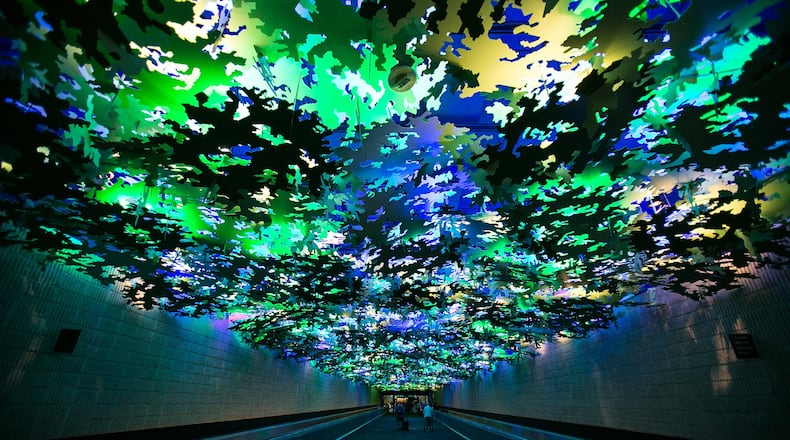You’re shuffling to baggage claim, or scrambling to make a flight, engaged in the anxiety-fueled grind that travel has become when you look up and see something beautiful, thought-provoking, a piece of art that maybe even challenges the way you think about the world.
It’s one of the goals of art, to inspire and invite contemplation, and it has transformed Atlanta’s Hartsfield-Jackson International Airport into the unlikely headquarters of the largest art exhibition in the city at any given time with some $15 million already spent on art. The budget for the program is a mix of the 1 percent of city capital projects captured by Atlanta’s public art master plan and in addition, airport-associated fees such as lease payments by airlines and parking revenue that go to pay for art projects.
Launched in 1980, the Atlanta airport’s art program is an enormous, multifaceted exhibition of artworks seen by some 270,000 people every day (as well as the 60,000 employees who work at the Atlanta airport), drool-worthy figures for any museum or gallery space.
“A piece of art located in a prominent spot in the airport will be seen by as many people in a week as visit MoMA (the Museum of Modern Art) over the course of a year,” says Benjamin Austin, one of two program managers at the Airport Art Program alongside David Vogt. With that kind of scope, Austin notes, “you’re bound to make an impact on people.”
RELATED: Follow coverage of Hartsfield-Jackson International Airport by the AJC’s Kelly Yamanouchi
Creating ‘a sense of place’
Inherently democratic, unlike most museums or galleries, this artwork will never need to cajole or find its audience, because the audience finds it. Or at least stumbles across it, like the Pittsburgh family who stopped in front of an exhibition devoted to the legacy of the Rev. Martin Luther King Jr., their young daughter marveling at the happenstance of glass vitrines holding a suit jacket, a wristwatch and a baseball bat once owned by the same man she had just studied in her school history book.
“Ideally, we want to create a sense of place,” Vogt says of the Airport Art Program’s larger mission. Vogt has been with the program since 1996 and still speaks 22 years later, with a sense of excitement and purpose, about the power of art in this very public setting. The program itself is an eclectic mix of temporary exhibitions and permanent works from an array of international, national and regional artists.
"It is important to include not just national and international blue-chip artists, but significant works by some of the more important artists of the region, so the collection reflects its location — grounding visitors is critical," says former public art coordinator at the Fulton County Arts Council and Atlanta-based artist Gregor Turk, who also has a permanent work installed at the airport's Concourse E.
“I see the value of having the airport commission as a tremendous opportunity to reach a large, broad and diverse audience that normally might never see my work,” says Turk. “Being able to continually communicate and connect with individuals through my work is wonderful and probably the most singular attraction to airport commissions.”
RELATED: High Museum photography exhibit features views of Hartsfield-Jackson
Challenges of choosing, installing art
In 2017, the Airport Art Program was among a dozen recipients of the Governor’s Awards for the Arts and Humanities in Georgia. The program’s impact is measurable, in the number of eyes on the work on a daily basis. Posts on Instagram and the Atlanta airport Twitter account speak to the impact of the art on view. But it’s also ephemeral — how does art affect a harried traveler, how does it change their outlook and perhaps inspire them to seek out other opportunities to engage with art?
Bringing art to the airport is a complex process in almost every way. Selecting a work of art most often involves the airport program managers proposing a pool of artists to choose from, convening a panel of from three to nine local or — less frequently — national art authorities to select an artist, followed by a series of internal approvals, then legislation submitted that authorizes the mayor to enter into an agreement with the artist and finally contracting the work. Because work is not chosen by the program administrators in most cases (temporary exhibitions are the exception), the work is a cross section of diverse artistic styles rather than just a reflection of the Airport Art Program managers’ vision.
The physical process of then exhibiting art in the airport comes with its own challenges. All works, even massive Zimbabwe stone sculptures, pass through the same security system used by passengers, so the works often are dismantled into smaller pieces in order to fit. Work is installed in the middle of the night so as not to disrupt passenger flow and airport operations. It’s a grueling process for the program managers, who typically cap a full day at the office with an all-nighter supervising installation. “It’s pretty brutal,” admits Vogt.
As the program has matured, its commissions have often become more sophisticated, ambitious, with more multimedia elements and internationally known artists involved, like Donald Lipski and the international art team Uebersee, both commissioned to create permanent works for the opening of the Maynard H. Jackson Jr. International Terminal in 2012.
One of the most impactful of the airport's recent additions is a $4 million work from Chicago artist Steve Waldeck, "Flight Paths," installed in 2016 between terminals A and B, the largest public art project in the city of Atlanta's history and the final work created by Waldeck before his death from Alzheimer's in 2017. Meant to evoke a forest teeming with bird song, the piece makes a parallel between the airport's buzzing activity and natural systems, and is one of Vogt's favorites for its ability to transport and delight passengers who have even bunked down in the soothing dark passage below the artwork to nap or rest. It is also the most Instagrammed of the airport artworks.
“In terms of transforming this corridor, it’s a home run,” says Vogt, who admits: “Part of why we have an art program is to also alleviate a lot of the stress that is associated with travel.”
A widening impact
Though part of the program's focus has always been collaborations with Atlanta institutions like the Atlanta History Center or the Atlanta Contemporary, that agenda has expanded and deepened over the years. An upcoming exhibition will focus on artists' books done in collaboration with the AJC Decatur Book Festival, local avant-garde film enthusiast Andy Ditzler will bring some of his Film Love programming to the airport, and even the Atlanta mural project Living Walls will soon bring its vibrant approach to street art to the world's busiest airport. Austin, who holds a graduate degree in film from Emory University, has a particular interest in bringing more film into the space, maybe even a movie theater someday.
The Airport Art Program is also working to incorporate more performing arts into the airport and even an artist-in-residency program.
Upcoming temporary exhibitions will be devoted to photographer Gordon Parks' images of Muhammad Ali and to civil rights leader and congressman John Lewis, the subject of a forthcoming exhibition in the airport's atrium.
The airport is also upping its game when it comes to bringing innovative and high-caliber work to the airport. Known for creating works that respond to their environments, MacArthur Genius Award winner Ned Kahn will create a $2 million kinetic artwork for the facade of a new long-term parking deck in the College Park neighborhood surrounding the airport, slated to be completed in 2020. Also on the horizon is a projected $400,000-$500,000 budget for a tiered staircase that adjoins the escalator ascending to Concourse D, for which a shortlist of local, national and international artists has been assembled. And the artist team of Hypersonic-Plebian Design will collaborate on a monumental, suspended sculpture for the Domestic Terminal atrium.
At its heart, the Airport Art Program represents an opportunity to make art a daily occurrence, a stress-reliever and moment of beauty in a great number of people’s lives.
“Of course, we’re trying to engage passengers and slow up and enjoy life a little bit,” says Vogt.
But for the city itself, it may be the most subtle, sophisticated piece of boosterism going, a living, breathing billboard for Atlanta’s cultural relevance. Thanks to Hartsfield-Jackson International Airport’s Airport Art Program, travelers passing through the airport, who may not engage with art on a daily basis, can have a taste of what Atlanta and Georgia have to offer, even if they never make it out of the terminal. The growing importance of public art programs in the nation’s airports even as other funding streams for the arts have diminished testifies to how impactful these programs are as vibrant advertisement for the city itself.
“It presents a great opportunity for us to share the sense of the complexities of what Atlanta is,” affirms Vogt.
About the Author
Keep Reading
The Latest
Featured





